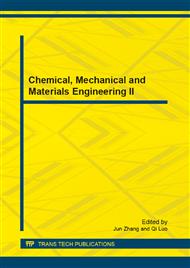[1]
S. Kim, M. Miyayama, H. Yanagida, J. Ceram. Soc. Jpn. 102(1995) 315.
Google Scholar
[2]
I. Yi, M. Miyayama, Trans. Mater. Res. Soc. Jpn. 20 (1996) 660.
Google Scholar
[3]
S.M. Huang, C.D. Feng, M. Gu, Y.C. Li, J. Alloys Compd. 472 (2009) 262.
Google Scholar
[4]
B.H. Park, B.S. Kang, S.D. Bu, T.W. Noh, J. Lee, W. Joe., J. Nat. (London) 401 (1999) 682.
Google Scholar
[5]
M.L. Zhao, Q.Z. Wu, C.L. Wang, J.L. Zhang, Z.G. Gai, C.M. Wang, J. Alloys Compd. 476 (2009) 393.
Google Scholar
[6]
M.A. Zurbuchen, G. Asayama, D.G. Schlom, S.K. Streiffer, Phys. Rev. Lett. 88 (2002) 107601.
Google Scholar
[7]
H. Yan, H. Zang, M.J. Reece, X. Dong, Appl. Phys. Lett. 87 (2005) 082911–082913.
Google Scholar
[8]
H. Du, W. Zhou, F. Luo, D. Zhu, S. Qu, Z. Pei, Appl. Phys. Lett. 91 (2007) 182909–182911.
Google Scholar
[9]
E.C. Subbarao, J. Phys. Chem. Solids 23 (1962) 665.
Google Scholar
[10]
Y. Park, M. Miyayama, T. Kudo, J. Ceram . Soc. Jpn. 107 (1999) 413.
Google Scholar
[11]
S. Kumar,K. B. R. Varma, J. Phys. D: Appl. Phys. 42 (2009) 075405.
Google Scholar
[12]
Sunil Kumar, K. B. R. Varma, Adv. Sci. Lett. 3 (2010) 20.
Google Scholar
[13]
V. B. Santos, J.-C. M'Peko, M. Mir, V. R. Mastelaro, A.C. Hernandes, J. Eur. Ceram. Soc. 29 (2009) 751–756.
Google Scholar
[14]
X. B. Chen, R. Hui, J. Zhu, W. P. Lu, X. Y. Mao, J. Appl. Phys. 96 (2004) 5697–5700.
Google Scholar
[15]
H. Sun, X. B. Chen, J. Zhu, J. H. He, Y.F. Qian, H. Fang, J. Sol–Gel Sci. Technol. 43(2007) 125–129.
Google Scholar
[16]
A. Z. Simoes, C. S. Riccardi, F. Moura, A. Ries, N.L.A. Junior, M.A. Zaghete, B. Stojanovic, E. Longo, J.A. Varela, Mater. Lett. 58 (2004) 2842–2847.
DOI: 10.1016/j.matlet.2004.04.025
Google Scholar
[17]
CARL. K, HAERDTL. K. H. Electrical after-effects in Pb(Ti, Zr)O3 ceramics [J]. Ferroelectrics, 1978, 17(3): 473-486.
DOI: 10.1080/00150197808236770
Google Scholar
[18]
ROBELS U, ARLT. G. Domain wall clamping in ferroelectrics by orientation of defects [J]. J Appl Phys, 1993, 73(4): 3454-3459.
DOI: 10.1063/1.352948
Google Scholar
[19]
CAO W, RANDALLCA. "Grain size and domain size relations in bulk ceramic ferroelectric materials." [J]. J Phys Chem Solids, 1996, 57(10): 1499-1505.
DOI: 10.1016/0022-3697(96)00019-4
Google Scholar


